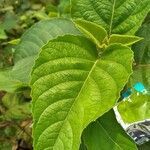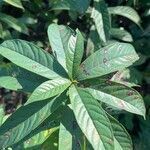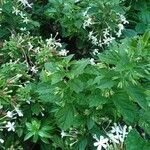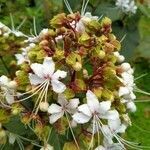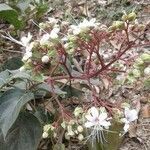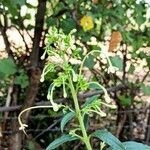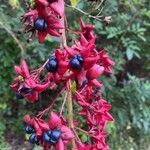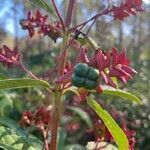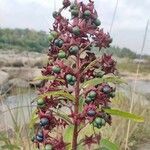Subshrubs to shrubs 1-2 m tall. Branchlets purple to purplish, channeled, smooth. Leaves whorled with 3-5 per node or opposite, sessile or subsessile, with nodal hairs at petiole base; leaf blade narrowly lanceolate to oblong-lanceolate, 10-21 X 1.3-2.5 cm, membranous, glabrous, base attenuate, margin entire or sinuate, apex short acuminate; midvein prominent, veins 10-12 pairs. Inflorescences terminal leafy thyrses, 20-45 X 10-15 cm; cymes red, few flowered; peduncle to 3 cm; bracts linear-lanceolate to lanceolate, 1-2 cm; bractlets awl-shaped. Calyx 1-1.5 cm, divided 3/4 to base, densely minute round glandular; lobes ovate-lanceolate, 8-15 X 3-6 mm, apex acute. Corolla white, becoming cream colored; tube funnelform, curved, 5-9 cm; lobes spreading, lanceolate, elliptic, or ovate-oblong, 8-15 3-6 mm, apex obtuse. Stamens long exserted. Ovary glabrous. Style longer than stamens. Fruiting calyx crimson, to 3.8 cm in diam., leathery. Drupes dark blue, ca. 1.2 cm in diam., 2-4-lobed depending on number of pyrenes. Fl. and fr. Aug-Nov.
More
A shrub. It grows to about 2.5 m high. It has fluted, hollow stems. The leaves are 6-23 cm long by 1-5 cm wide. The leaves are sword shaped and narrow towards the base. The flowers are white and fade to yellow. They occur in a panicle at the end of the branches. The fruit is fleshy with one stone inside. It is dark blue and has a red calyx.
A tropical plant. Plants grow in Nepal from 200-1400 m altitude. They grow in open places. It can grow in average, well-drained soil. In southern China it grows on mountain slopes between 500-1,000 m above sea level.
More
Roadsides and open places on mountain slopes; at elevations from 200-1,400 metres.
